
OSAKA, JAPAN, 19 OCTOBER 2014: Sensei Fumon Tanaka, 73, Samurai master and descendent of a long line of Samurai warriors in Japan. He is seen at a temple complex in Osaka, Japan. Sensei Tanaka is somewhat controversial amongst the pursuants of the Samurai arts in that he embraces the media and has appeared in films, documentaries and commercials all showcasing his Samurai martial arts skills. This is controversial in Samurai culture as many pursuants believe in secrecy and humbleness and not in ostentatious display.

SHIMIZU KU, SHIZUOKA CITY, TOKYO, 16 OCTOBER 2014: Advanced students practise sword skills in the dojo of Master Sensei Yoshimitsu (Kagehiro) Katsuse, a master of all 18 of the Samurai arts. This dojo dates back to the 16th century and is one of very few pure Samurai dojos that survive today.
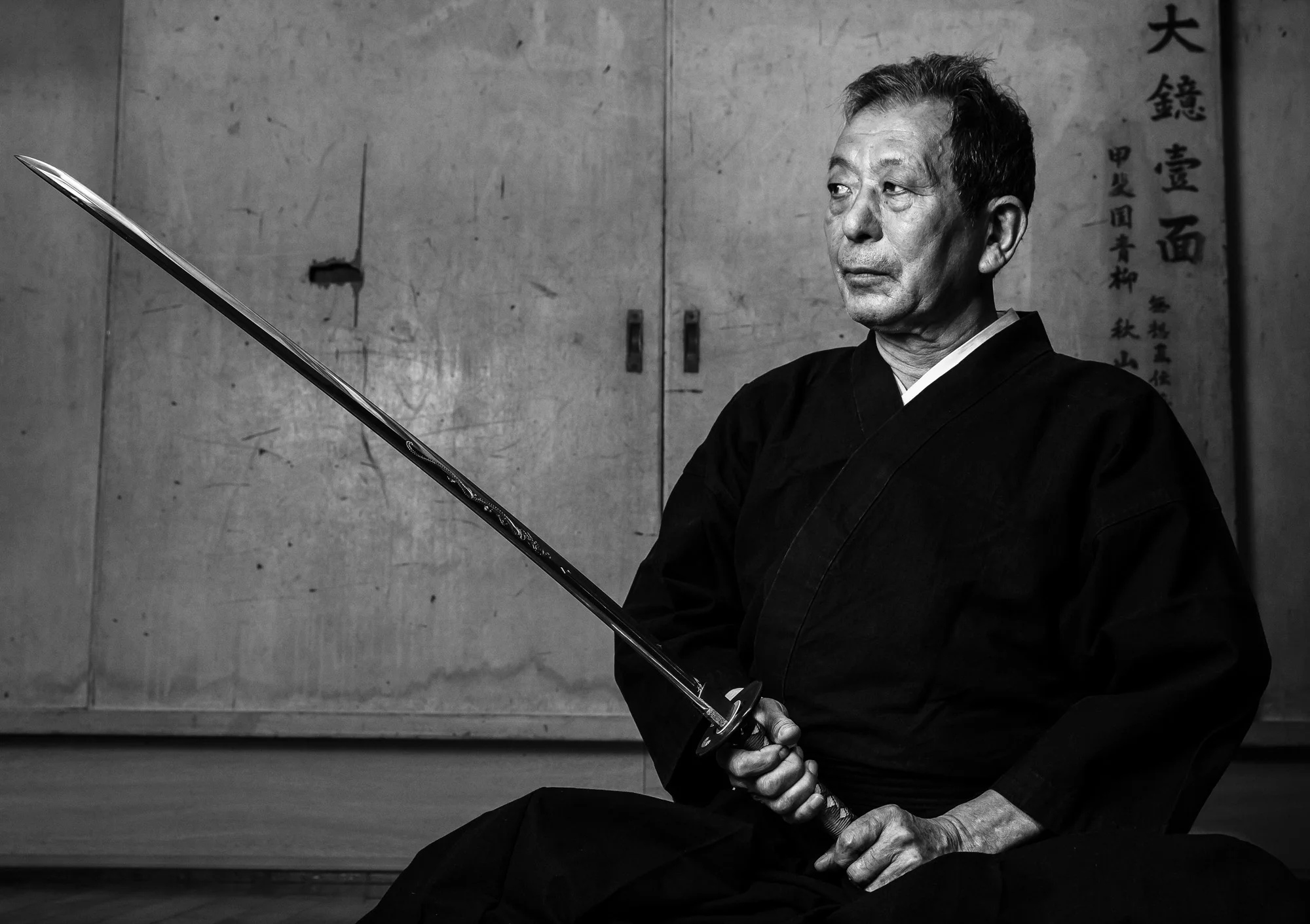
SHIMIZU KU, SHIZUOKA CITY, TOKYO, 16 OCTOBER 2014: Master Sensei Yoshimitsu (Kagehiro) Katsuse, a master of all 18 of the Samurai arts. The sensei is a direct descent of a particular line of Samurai masters who date back to the 16th century.
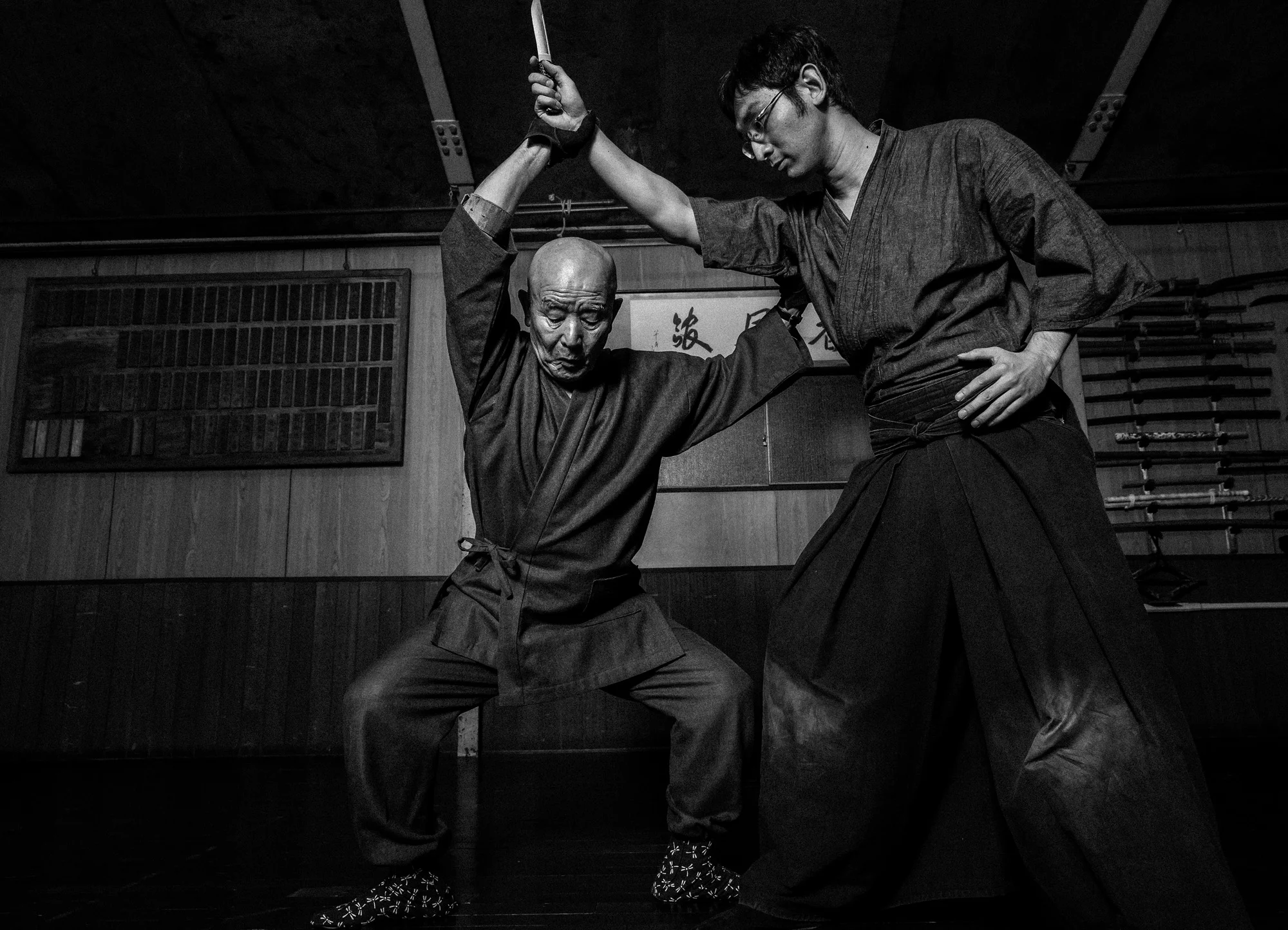
NAGOYA CITY, JAPAN, 17 OCTOBER 2014: Master Sensei Kato, 81, corrects a student's technique at his Nagoya city dojo. Sensei Kato runs the auspicious Owari Kan Ryu school where he himself studied under his master from the age of 25. Kato is a traditionalist and teaches a specific version of the way of the Samurai, techniques which date back to the 15th century.

TOKYO, JAPAN, 22 OCTOBER 2014: Master Japanese swordsmith Yoshindo Yoshihara polishes a recently completed Katana sword in a room in his home in Tokyo, Japan. The Japanese sword is renowned for its excellence. There is a centuries old tradition of swordmaking in Japan, stretching back over a 1000 years. These days it remains a profession of very few craftsmen, with a even fewer master swordsmiths amongst them. The sword remains popular globally with those who can afford them. Prices can reach over 3 million Euros for an antique sword from a distinguished Samurai lineage.
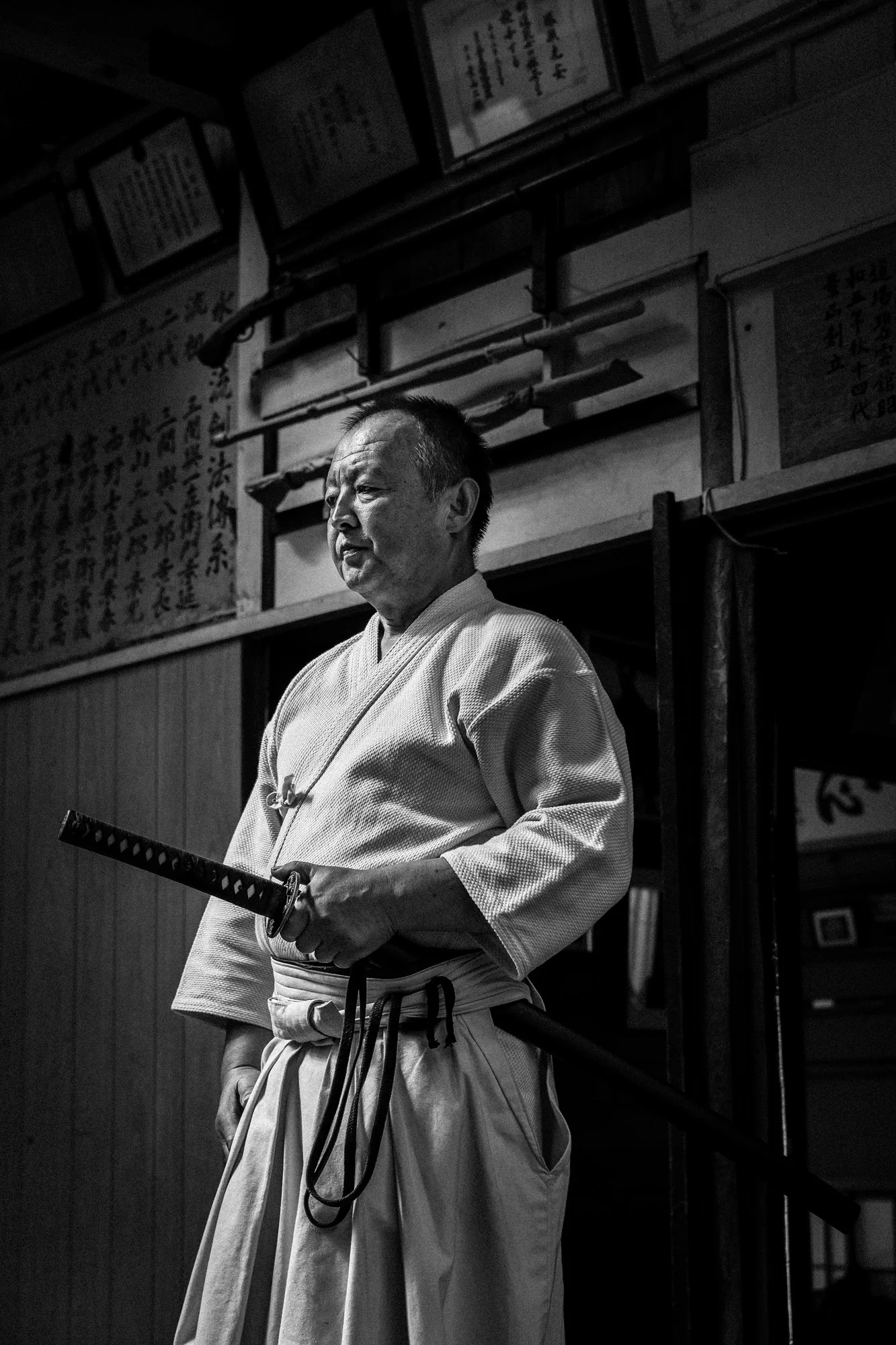
SHIMIZU KU, SHIZUOKA CITY, TOKYO, 16 OCTOBER 2014: Images from the dojo of Master Sensei Yoshimitsu (Kagehiro) Katsuse, a master of all 18 of the Samurai arts. He is known as the 15th sōke of Suiō-ryū, a form of Japanese martial arts which dates back to 1615. Katsuse Yoshimitsu Kagehir is seen with his son, his advanced students and with his collection of prestigious Katana swords. His students are seen practising their various katas. The founder's son Yohachirō succeeded his father to become the 2nd head of the tradition and the lineage has continued unbroken to the present day. Traditionally, the kage waza were shared only with the successor to the tradition, in a form of transmission called isshi sōden. However, now nearly all of the physical techniques of the tradition are taught openly. Even today though, one set of iai kata, which represent the very essence of the tradition's teachings, is set aside only for communication to the tradition's next sōke. (Photo by Brent Stirton/Reportage by Getty Images for Le Figaro Magazine.)

TOKYO UNIVERSITY, TOKYO, JAPAN, 25 OCTOBER 2014: A female Kyudo archer holds her form after she releases her arrow at Tokyo University Kyudo dojo, Tokyo, Japan. Kyudo is seen by its practioners as more of a moving meditation than a sport of archery, with an emphasis on breath and perfection of movement. It is seen as one of the most static of the Bushido Samurai arts. All of the Samurai arts have aspects which stress these points of technique, artistry and flow.

SHIMIZU KU, SHIZUOKA CITY, TOKYO, 16 OCTOBER 2014: Master Sensei Yoshimitsu Katsuse, a master of all 18 of the Samurai arts, is seen practising his skills with his son while utilizing an ancient Samurai weapon which allowed combat against skilled swordsman from a distance. Most of these skills and techniques reside in the hands of only a few Samurai masters who survive today. Their secrets are closely guarded and passed down in their entirety to only one man at a time. Sensei Katsuse is the current guardian of these techniques and can trace his line back to the 16th century.

SHIMIZU KU, SHIZUOKA CITY, TOKYO, 16 OCTOBER 2014: Images from the dojo of Master Sensei Yoshimitsu (Kagehiro) Katsuse, a master of all 18 of the Samurai arts. He is known as the 15th sōke of Suiō-ryū, a form of Japanese martial arts which dates back to 1615. Katsuse Yoshimitsu Kagehir is seen with his son, his advanced students and with his collection of prestigious Katana swords. His students are seen practising their various katas. The founder's son Yohachirō succeeded his father to become the 2nd head of the tradition and the lineage has continued unbroken to the present day. Traditionally, the kage waza were shared only with the successor to the tradition, in a form of transmission called isshi sōden. However, now nearly all of the physical techniques of the tradition are taught openly. Even today though, one set of iai kata, which represent the very essence of the tradition's teachings, is set aside only for communication to the tradition's next sōke. (Photo by Brent Stirton/Reportage by Getty Images for Le Figaro Magazine.)

NAGOYA CITY, JAPAN, 17 OCTOBER 2014: Boys practise Samurai Bushido techniques in the dojo of Master Sensei Kato, 81, who runs the Owari Kan Ryu school where he himself studied under his master from the age of 25. Kato is a traditionalist in the way of the Samurai, he teaches in a way which dates back to the 15th century. There are very few of these masters still alive today and the passing of these skills to chosen students is an important part of the maintenance of this aspect of Japanese culture.


OKINAWA, JAPAN, 19 OCTOBER 2014: Sensei Hatsumi, 83, was born in Noda, Chiba on December 2, 1931. He participated in sports during his school years, along with martial arts and theater, including becoming "captain of the football team". While attending the Meiji University,,he continued learning judo and eventually rose to Yudansha or Dan rank. He also began teaching Judo during his time at the university to American soldiers at the nearby Yokota Air Base. After graduating, Hatsumi began to search for a teacher to further his study of martial arts and when he was 26 he met Toshitsugu Takamatsu, known as "the Tiger of Mongolia". Hatsumi was accepted as Takamatsu's student and spent fifteen years on Honshu Island learning various ninjutsu styles from Takamatsu and other members of the Takamatsu family, also he continued to learn judo, Shito Ryu karate, aikido, and kobudo. Masaaki Hatsumi focuses the training of the Bujinkan on the "feeling" of technique or what he terms the feeling of real situations. Hatsumi has a non-standoffish teaching approach, leading Black Belt magazine to call him "wild, funny, unpredictable, and a cross between Charlie Chaplin and Obi-Wan Kenobi." Hatsumi focuses on teaching taijutsu to his students, as the other ninja arts have no need to be practiced in modern times, besides for "historical study" He has also served as a martial arts advisor to various films and television productions, including the James Bond movie You Only Live Twice, and in the first film from the highly popular Japanese series Shinobi no Mono. He also appeared in and was the stunt coordinator for the Japanese tokusatsu television series Sekai Ninja Sen Jiraiya as the titular hero's mentor and father figure, Tetsuzan Yamaji. Hatsumi's dojo is always full, with more than 100 experienced martial artists from all over the world attending expensive classes. Hatsumi has a long history teaching the military, police and other more clandestine organizations. (Photo by Brent Stir



OKINAWA, JAPAN, 19 OCTOBER 2014: Sensei Hatsumi, 83, was born in Noda, Chiba on December 2, 1931. He participated in sports during his school years, along with martial arts and theater, including becoming "captain of the football team". While attending the Meiji University,,he continued learning judo and eventually rose to Yudansha or Dan rank. He also began teaching Judo during his time at the university to American soldiers at the nearby Yokota Air Base. After graduating, Hatsumi began to search for a teacher to further his study of martial arts and when he was 26 he met Toshitsugu Takamatsu, known as "the Tiger of Mongolia". Hatsumi was accepted as Takamatsu's student and spent fifteen years on Honshu Island learning various ninjutsu styles from Takamatsu and other members of the Takamatsu family, also he continued to learn judo, Shito Ryu karate, aikido, and kobudo. Masaaki Hatsumi focuses the training of the Bujinkan on the "feeling" of technique or what he terms the feeling of real situations. Hatsumi has a non-standoffish teaching approach, leading Black Belt magazine to call him "wild, funny, unpredictable, and a cross between Charlie Chaplin and Obi-Wan Kenobi." Hatsumi focuses on teaching taijutsu to his students, as the other ninja arts have no need to be practiced in modern times, besides for "historical study" He has also served as a martial arts advisor to various films and television productions, including the James Bond movie You Only Live Twice, and in the first film from the highly popular Japanese series Shinobi no Mono. He also appeared in and was the stunt coordinator for the Japanese tokusatsu television series Sekai Ninja Sen Jiraiya as the titular hero's mentor and father figure, Tetsuzan Yamaji. Hatsumi's dojo is always full, with more than 100 experienced martial artists from all over the world attending expensive classes. Hatsumi has a long history teaching the military, police and other more clandestine organizations. (Photo by Brent Stir

OKINAWA, JAPAN, 19 OCTOBER 2014: Sensei Hatsumi, 83, was born in Noda, Chiba on December 2, 1931. He participated in sports during his school years, along with martial arts and theater, including becoming "captain of the football team". While attending the Meiji University,,he continued learning judo and eventually rose to Yudansha or Dan rank. He also began teaching Judo during his time at the university to American soldiers at the nearby Yokota Air Base. After graduating, Hatsumi began to search for a teacher to further his study of martial arts and when he was 26 he met Toshitsugu Takamatsu, known as "the Tiger of Mongolia". Hatsumi was accepted as Takamatsu's student and spent fifteen years on Honshu Island learning various ninjutsu styles from Takamatsu and other members of the Takamatsu family, also he continued to learn judo, Shito Ryu karate, aikido, and kobudo. Masaaki Hatsumi focuses the training of the Bujinkan on the "feeling" of technique or what he terms the feeling of real situations. Hatsumi has a non-standoffish teaching approach, leading Black Belt magazine to call him "wild, funny, unpredictable, and a cross between Charlie Chaplin and Obi-Wan Kenobi." Hatsumi focuses on teaching taijutsu to his students, as the other ninja arts have no need to be practiced in modern times, besides for "historical study" He has also served as a martial arts advisor to various films and television productions, including the James Bond movie You Only Live Twice, and in the first film from the highly popular Japanese series Shinobi no Mono. He also appeared in and was the stunt coordinator for the Japanese tokusatsu television series Sekai Ninja Sen Jiraiya as the titular hero's mentor and father figure, Tetsuzan Yamaji. Hatsumi's dojo is always full, with more than 100 experienced martial artists from all over the world attending expensive classes. Hatsumi has a long history teaching the military, police and other more clandestine organizations. (Photo by Brent Stir

NAGOYA CITY, JAPAN, 17 OCTOBER 2014: The dojo of Master Sensei Kato, 81, who runs the Owari Kan Ryu school where he himself studied under his master from the age of 25. Kato is a traditionalist and showed his family Scrolls, the way of the Samurai, which date back to the 15th century. Kato has a number of foreign students, including Alex Krupp, a dedicated American from Boston. Kato-sensei was born in Tokyo. He began Aikido training in 1954 at Aikido World Headquarters (Hombu Dojo) under the instruction of the Founder of Aikido, Morihei Ueshiba otherwise known as O’Sensei. Introduced to the Aikikai Hombu Dojo through his mother’s network of connections when he was 19, he trained there daily as well as spending long hours perfecting his personal practice. Working during the day as a printer, he attended classes at night, and for this reason he was unable to be an uchideshi, and does not appear in early photographs with them. He continued to train for over 52 years at the Aikikai Hombu Dojo although he later primarily taught at his Suginami Dojo, but he still attended special events at Aikikai Hombu dojo. After his first 10 years at Hombu Dojo, Kato-sensei occasionally had chances to personally serve the Founder. He is still pursuing Aikido through the Founder’s image, as according to Kato-sensei, “To me, the Founder is not dead. He is still alive in my mind and in my heart.” Kato attended Doshu’s class over three generations: the Founder, the second Doshu, and the current third Doshu. He received his first six black belts from the Founder and his next two black belts from the second Doshu. His self-training in Aikido has been ascetic. In his early years, he often used to practice weapons by himself through the night, greet sunrise the next morning, and then go to work again. Kato's Aikido had a measure of personal spirituality to it. Before every class, Kato Sensei arrived early to the dojo to meditate. Since he was young, he visited mountain shrines and

NAGOYA CITY, JAPAN, 17 OCTOBER 2014: The dojo of Master Sensei Kato, 81, who runs the Owari Kan Ryu school where he himself studied under his master from the age of 25. Kato is a traditionalist and showed his family Scrolls, the way of the Samurai, which date back to the 15th century. Kato has a number of foreign students, including Alex Krupp, a dedicated American from Boston. Kato-sensei was born in Tokyo. He began Aikido training in 1954 at Aikido World Headquarters (Hombu Dojo) under the instruction of the Founder of Aikido, Morihei Ueshiba otherwise known as O’Sensei. Introduced to the Aikikai Hombu Dojo through his mother’s network of connections when he was 19, he trained there daily as well as spending long hours perfecting his personal practice. Working during the day as a printer, he attended classes at night, and for this reason he was unable to be an uchideshi, and does not appear in early photographs with them. He continued to train for over 52 years at the Aikikai Hombu Dojo although he later primarily taught at his Suginami Dojo, but he still attended special events at Aikikai Hombu dojo. After his first 10 years at Hombu Dojo, Kato-sensei occasionally had chances to personally serve the Founder. He is still pursuing Aikido through the Founder’s image, as according to Kato-sensei, “To me, the Founder is not dead. He is still alive in my mind and in my heart.” Kato attended Doshu’s class over three generations: the Founder, the second Doshu, and the current third Doshu. He received his first six black belts from the Founder and his next two black belts from the second Doshu. His self-training in Aikido has been ascetic. In his early years, he often used to practice weapons by himself through the night, greet sunrise the next morning, and then go to work again. Kato's Aikido had a measure of personal spirituality to it. Before every class, Kato Sensei arrived early to the dojo to meditate. Since he was young, he visited mountain shrines and

NAGOYA CITY, JAPAN, 17 OCTOBER 2014: The dojo of Master Sensei Kato, 81, who runs the Owari Kan Ryu school where he himself studied under his master from the age of 25. Kato is a traditionalist and showed his family Scrolls, the way of the Samurai, which date back to the 15th century. Kato has a number of foreign students, including Alex Krupp, a dedicated American from Boston. Kato-sensei was born in Tokyo. He began Aikido training in 1954 at Aikido World Headquarters (Hombu Dojo) under the instruction of the Founder of Aikido, Morihei Ueshiba otherwise known as O’Sensei. Introduced to the Aikikai Hombu Dojo through his mother’s network of connections when he was 19, he trained there daily as well as spending long hours perfecting his personal practice. Working during the day as a printer, he attended classes at night, and for this reason he was unable to be an uchideshi, and does not appear in early photographs with them. He continued to train for over 52 years at the Aikikai Hombu Dojo although he later primarily taught at his Suginami Dojo, but he still attended special events at Aikikai Hombu dojo. After his first 10 years at Hombu Dojo, Kato-sensei occasionally had chances to personally serve the Founder. He is still pursuing Aikido through the Founder’s image, as according to Kato-sensei, “To me, the Founder is not dead. He is still alive in my mind and in my heart.” Kato attended Doshu’s class over three generations: the Founder, the second Doshu, and the current third Doshu. He received his first six black belts from the Founder and his next two black belts from the second Doshu. His self-training in Aikido has been ascetic. In his early years, he often used to practice weapons by himself through the night, greet sunrise the next morning, and then go to work again. Kato's Aikido had a measure of personal spirituality to it. Before every class, Kato Sensei arrived early to the dojo to meditate. Since he was young, he visited mountain shrines and
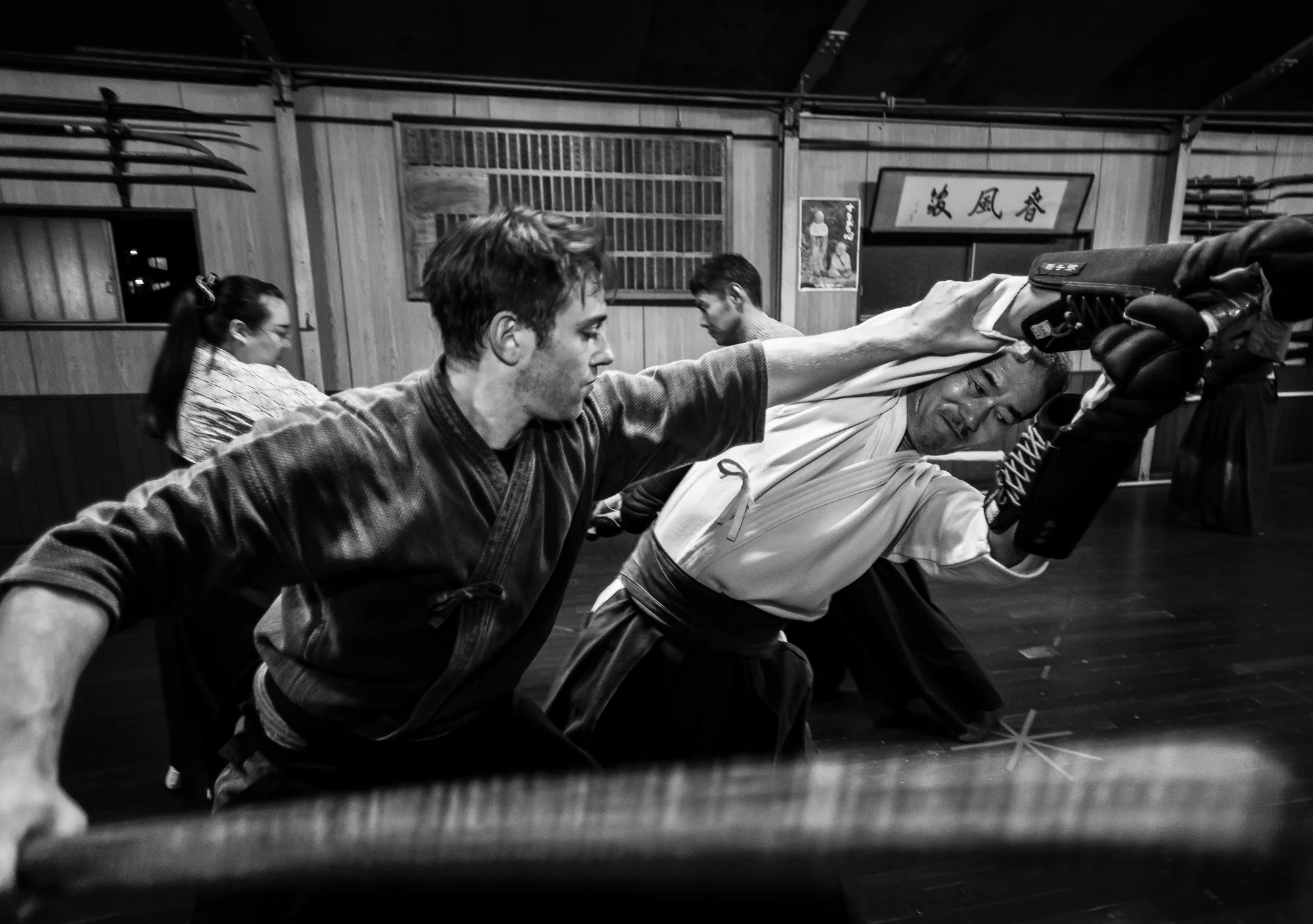
NAGOYA CITY, JAPAN, 17 OCTOBER 2014: Alex Krupp, a dedicated American from Boston, practises Samurai Bushido skills in the dojo of Master Sensei Kato, 81, who runs the Owari Kan Ryu school where he himself studied under his master from the age of 25. Kato is a traditionalist and teaches techniques in the way of the Samurai that date back to the 15th century. Kato has a number of foreign students, the skills of the Samurai have continued to draw these students from all over the world.

NAGOYA CITY, JAPAN, 17 OCTOBER 2014: The dojo of Master Sensei Kato, 81, who runs the Owari Kan Ryu school where he himself studied under his master from the age of 25. Kato is a traditionalist and showed his family Scrolls, the way of the Samurai, which date back to the 15th century. Kato has a number of foreign students, including Alex Krupp, a dedicated American from Boston. Kato-sensei was born in Tokyo. He began Aikido training in 1954 at Aikido World Headquarters (Hombu Dojo) under the instruction of the Founder of Aikido, Morihei Ueshiba otherwise known as O’Sensei. Introduced to the Aikikai Hombu Dojo through his mother’s network of connections when he was 19, he trained there daily as well as spending long hours perfecting his personal practice. Working during the day as a printer, he attended classes at night, and for this reason he was unable to be an uchideshi, and does not appear in early photographs with them. He continued to train for over 52 years at the Aikikai Hombu Dojo although he later primarily taught at his Suginami Dojo, but he still attended special events at Aikikai Hombu dojo. After his first 10 years at Hombu Dojo, Kato-sensei occasionally had chances to personally serve the Founder. He is still pursuing Aikido through the Founder’s image, as according to Kato-sensei, “To me, the Founder is not dead. He is still alive in my mind and in my heart.” Kato attended Doshu’s class over three generations: the Founder, the second Doshu, and the current third Doshu. He received his first six black belts from the Founder and his next two black belts from the second Doshu. His self-training in Aikido has been ascetic. In his early years, he often used to practice weapons by himself through the night, greet sunrise the next morning, and then go to work again. Kato's Aikido had a measure of personal spirituality to it. Before every class, Kato Sensei arrived early to the dojo to meditate. Since he was young, he visited mountain shrines and

NAGOYA CITY, JAPAN, 17 OCTOBER 2014: The dojo of Master Sensei Kato, 81, who runs the Owari Kan Ryu school where he himself studied under his master from the age of 25. Kato is a traditionalist and showed his family Scrolls, the way of the Samurai, which date back to the 15th century. Kato has a number of foreign students, including Alex Krupp, a dedicated American from Boston. Kato-sensei was born in Tokyo. He began Aikido training in 1954 at Aikido World Headquarters (Hombu Dojo) under the instruction of the Founder of Aikido, Morihei Ueshiba otherwise known as O’Sensei. Introduced to the Aikikai Hombu Dojo through his mother’s network of connections when he was 19, he trained there daily as well as spending long hours perfecting his personal practice. Working during the day as a printer, he attended classes at night, and for this reason he was unable to be an uchideshi, and does not appear in early photographs with them. He continued to train for over 52 years at the Aikikai Hombu Dojo although he later primarily taught at his Suginami Dojo, but he still attended special events at Aikikai Hombu dojo. After his first 10 years at Hombu Dojo, Kato-sensei occasionally had chances to personally serve the Founder. He is still pursuing Aikido through the Founder’s image, as according to Kato-sensei, “To me, the Founder is not dead. He is still alive in my mind and in my heart.” Kato attended Doshu’s class over three generations: the Founder, the second Doshu, and the current third Doshu. He received his first six black belts from the Founder and his next two black belts from the second Doshu. His self-training in Aikido has been ascetic. In his early years, he often used to practice weapons by himself through the night, greet sunrise the next morning, and then go to work again. Kato's Aikido had a measure of personal spirituality to it. Before every class, Kato Sensei arrived early to the dojo to meditate. Since he was young, he visited mountain shrines and

NAGOYA CITY, JAPAN, 17 OCTOBER 2014: The dojo of Master Sensei Kato, 81, who runs the Owari Kan Ryu school where he himself studied under his master from the age of 25. Kato is a traditionalist and showed his family Scrolls, the way of the Samurai, which date back to the 15th century. Kato has a number of foreign students, including Alex Krupp, a dedicated American from Boston. Kato-sensei was born in Tokyo. He began Aikido training in 1954 at Aikido World Headquarters (Hombu Dojo) under the instruction of the Founder of Aikido, Morihei Ueshiba otherwise known as O’Sensei. Introduced to the Aikikai Hombu Dojo through his mother’s network of connections when he was 19, he trained there daily as well as spending long hours perfecting his personal practice. Working during the day as a printer, he attended classes at night, and for this reason he was unable to be an uchideshi, and does not appear in early photographs with them. He continued to train for over 52 years at the Aikikai Hombu Dojo although he later primarily taught at his Suginami Dojo, but he still attended special events at Aikikai Hombu dojo. After his first 10 years at Hombu Dojo, Kato-sensei occasionally had chances to personally serve the Founder. He is still pursuing Aikido through the Founder’s image, as according to Kato-sensei, “To me, the Founder is not dead. He is still alive in my mind and in my heart.” Kato attended Doshu’s class over three generations: the Founder, the second Doshu, and the current third Doshu. He received his first six black belts from the Founder and his next two black belts from the second Doshu. His self-training in Aikido has been ascetic. In his early years, he often used to practice weapons by himself through the night, greet sunrise the next morning, and then go to work again. Kato's Aikido had a measure of personal spirituality to it. Before every class, Kato Sensei arrived early to the dojo to meditate. Since he was young, he visited mountain shrines and

TOKYO, JAPAN, 18 OCTOBER 2014: Sensei Yagyu, a master whose family was important in the creation of 3 centuries of the warrior class of Japan. He is seen lecturing a group of students and also in his modern dojo. His classes represent the better off of those studying the warrior arts in Japan today, as does his dojo in a high rise building in Tokyo. Sensei Yagyu is a banker by profession and many in his class represent the far right in Japan. (Photo by Brent Stirton/Reportage by Getty Images
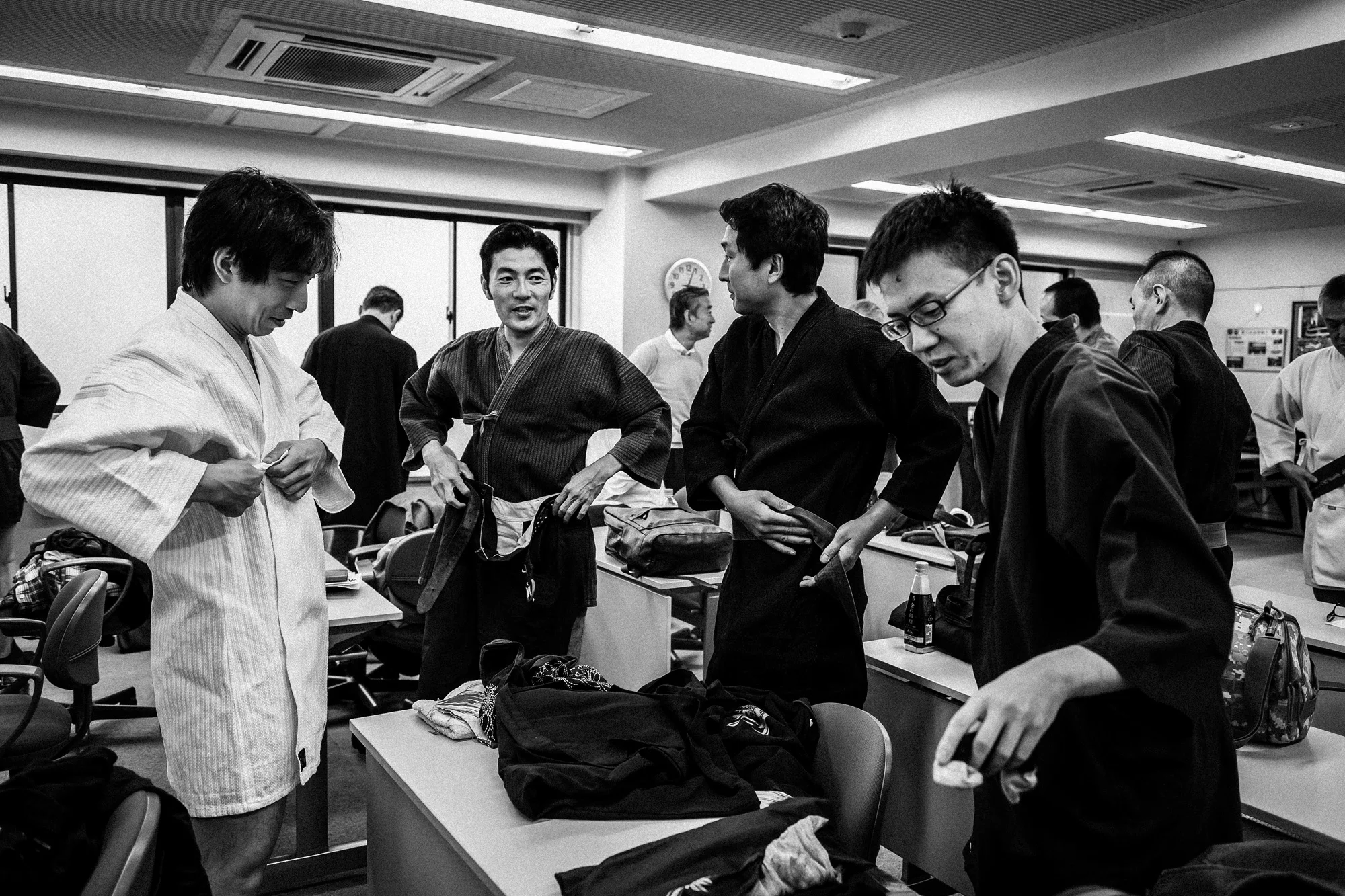
TOKYO, JAPAN, 18 OCTOBER 2014: Sensei Yagyu, a master whose family was important in the creation of 3 centuries of the warrior class of Japan. He is seen lecturing a group of students and also in his modern dojo. His classes represent the better off of those studying the warrior arts in Japan today, as does his dojo in a high rise building in Tokyo. Sensei Yagyu is a banker by profession and many in his class represent the far right in Japan. (Photo by Brent Stirton/Reportage by Getty Images

TOKYO, JAPAN, 18 OCTOBER 2014: Sensei Yagyu, a master whose family was important in the creation of 3 centuries of the warrior class of Japan. He is seen lecturing a group of students and also in his modern dojo. His classes represent the better off of those studying the warrior arts in Japan today, as does his dojo in a high rise building in Tokyo. Sensei Yagyu is a banker by profession and many in his class represent the far right in Japan. (Photo by Brent Stirton/Reportage by Getty Images

OKINAWA, JAPAN, 19 OCTOBER 2014: Sensei Hatsumi, 83, was born in Noda, Chiba on December 2, 1931. He participated in sports during his school years, along with martial arts and theater, including becoming "captain of the football team". While attending the Meiji University,,he continued learning judo and eventually rose to Yudansha or Dan rank. He also began teaching Judo during his time at the university to American soldiers at the nearby Yokota Air Base. After graduating, Hatsumi began to search for a teacher to further his study of martial arts and when he was 26 he met Toshitsugu Takamatsu, known as "the Tiger of Mongolia". Hatsumi was accepted as Takamatsu's student and spent fifteen years on Honshu Island learning various ninjutsu styles from Takamatsu and other members of the Takamatsu family, also he continued to learn judo, Shito Ryu karate, aikido, and kobudo. Masaaki Hatsumi focuses the training of the Bujinkan on the "feeling" of technique or what he terms the feeling of real situations. Hatsumi has a non-standoffish teaching approach, leading Black Belt magazine to call him "wild, funny, unpredictable, and a cross between Charlie Chaplin and Obi-Wan Kenobi." Hatsumi focuses on teaching taijutsu to his students, as the other ninja arts have no need to be practiced in modern times, besides for "historical study" He has also served as a martial arts advisor to various films and television productions, including the James Bond movie You Only Live Twice, and in the first film from the highly popular Japanese series Shinobi no Mono. He also appeared in and was the stunt coordinator for the Japanese tokusatsu television series Sekai Ninja Sen Jiraiya as the titular hero's mentor and father figure, Tetsuzan Yamaji. Hatsumi's dojo is always full, with more than 100 experienced martial artists from all over the world attending expensive classes. Hatsumi has a long history teaching the military, police and other more clandestine organizations. (Photo by Brent Stir

OKINAWA, JAPAN, 19 OCTOBER 2014: Sensei Hatsumi, 83, was born in Noda, Chiba on December 2, 1931. He participated in sports during his school years, along with martial arts and theater, including becoming "captain of the football team". While attending the Meiji University,,he continued learning judo and eventually rose to Yudansha or Dan rank. He also began teaching Judo during his time at the university to American soldiers at the nearby Yokota Air Base. After graduating, Hatsumi began to search for a teacher to further his study of martial arts and when he was 26 he met Toshitsugu Takamatsu, known as "the Tiger of Mongolia". Hatsumi was accepted as Takamatsu's student and spent fifteen years on Honshu Island learning various ninjutsu styles from Takamatsu and other members of the Takamatsu family, also he continued to learn judo, Shito Ryu karate, aikido, and kobudo. Masaaki Hatsumi focuses the training of the Bujinkan on the "feeling" of technique or what he terms the feeling of real situations. Hatsumi has a non-standoffish teaching approach, leading Black Belt magazine to call him "wild, funny, unpredictable, and a cross between Charlie Chaplin and Obi-Wan Kenobi." Hatsumi focuses on teaching taijutsu to his students, as the other ninja arts have no need to be practiced in modern times, besides for "historical study" He has also served as a martial arts advisor to various films and television productions, including the James Bond movie You Only Live Twice, and in the first film from the highly popular Japanese series Shinobi no Mono. He also appeared in and was the stunt coordinator for the Japanese tokusatsu television series Sekai Ninja Sen Jiraiya as the titular hero's mentor and father figure, Tetsuzan Yamaji. Hatsumi's dojo is always full, with more than 100 experienced martial artists from all over the world attending expensive classes. Hatsumi has a long history teaching the military, police and other more clandestine organizations. (Photo by Brent Stir
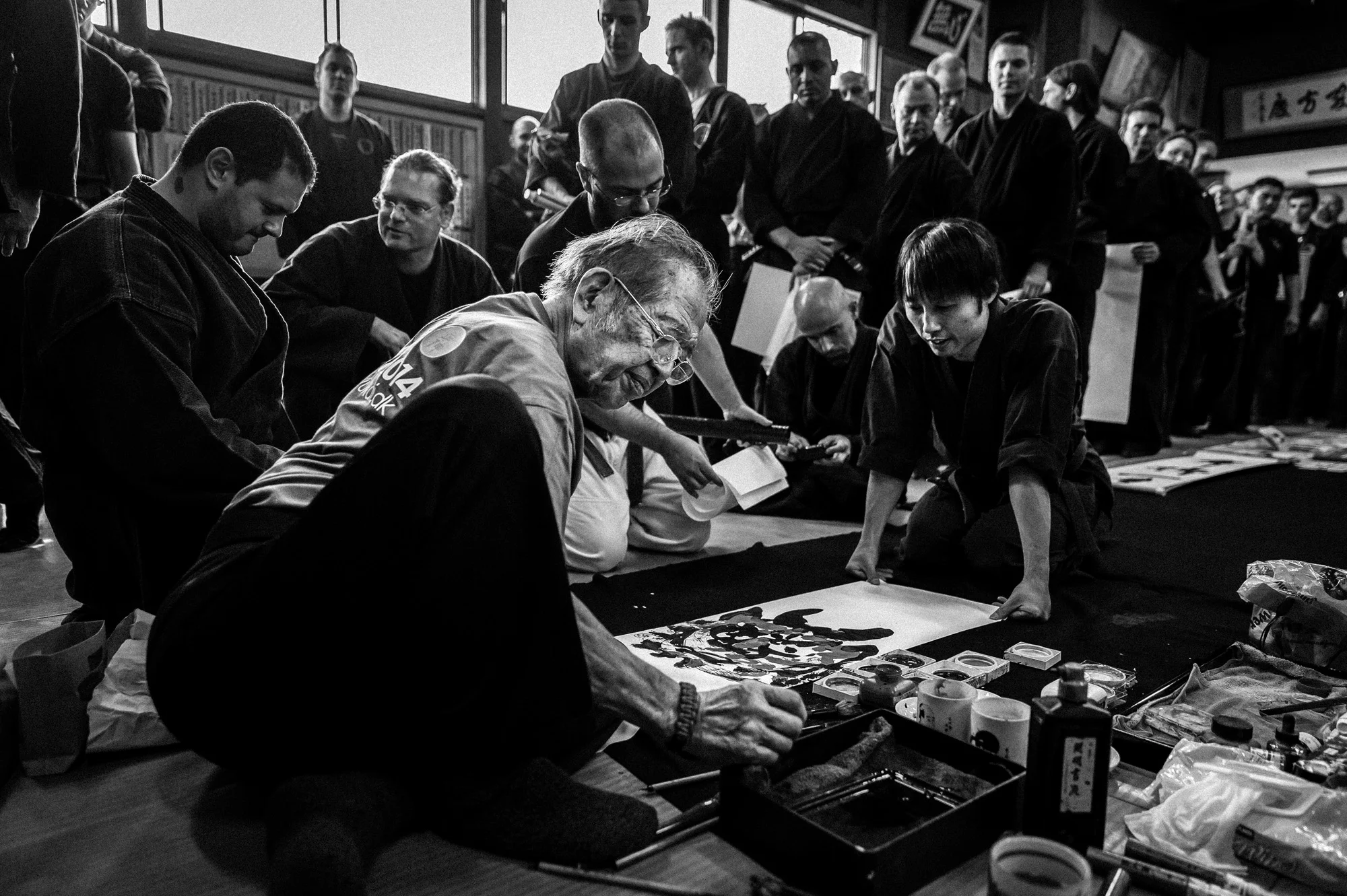
OKINAWA, JAPAN, 19 OCTOBER 2014: Sensei Hatsumi, 83, was born in Noda, Chiba on December 2, 1931. He participated in sports during his school years, along with martial arts and theater, including becoming "captain of the football team". While attending the Meiji University,,he continued learning judo and eventually rose to Yudansha or Dan rank. He also began teaching Judo during his time at the university to American soldiers at the nearby Yokota Air Base. After graduating, Hatsumi began to search for a teacher to further his study of martial arts and when he was 26 he met Toshitsugu Takamatsu, known as "the Tiger of Mongolia". Hatsumi was accepted as Takamatsu's student and spent fifteen years on Honshu Island learning various ninjutsu styles from Takamatsu and other members of the Takamatsu family, also he continued to learn judo, Shito Ryu karate, aikido, and kobudo. Masaaki Hatsumi focuses the training of the Bujinkan on the "feeling" of technique or what he terms the feeling of real situations. Hatsumi has a non-standoffish teaching approach, leading Black Belt magazine to call him "wild, funny, unpredictable, and a cross between Charlie Chaplin and Obi-Wan Kenobi." Hatsumi focuses on teaching taijutsu to his students, as the other ninja arts have no need to be practiced in modern times, besides for "historical study" He has also served as a martial arts advisor to various films and television productions, including the James Bond movie You Only Live Twice, and in the first film from the highly popular Japanese series Shinobi no Mono. He also appeared in and was the stunt coordinator for the Japanese tokusatsu television series Sekai Ninja Sen Jiraiya as the titular hero's mentor and father figure, Tetsuzan Yamaji. Hatsumi's dojo is always full, with more than 100 experienced martial artists from all over the world attending expensive classes. Hatsumi has a long history teaching the military, police and other more clandestine organizations. (Photo by Brent Stir

OKINAWA, JAPAN, 19 OCTOBER 2014: Sensei Hatsumi, 83, was born in Noda, Chiba on December 2, 1931. He participated in sports during his school years, along with martial arts and theater, including becoming "captain of the football team". While attending the Meiji University,,he continued learning judo and eventually rose to Yudansha or Dan rank. He also began teaching Judo during his time at the university to American soldiers at the nearby Yokota Air Base. After graduating, Hatsumi began to search for a teacher to further his study of martial arts and when he was 26 he met Toshitsugu Takamatsu, known as "the Tiger of Mongolia". Hatsumi was accepted as Takamatsu's student and spent fifteen years on Honshu Island learning various ninjutsu styles from Takamatsu and other members of the Takamatsu family, also he continued to learn judo, Shito Ryu karate, aikido, and kobudo. Masaaki Hatsumi focuses the training of the Bujinkan on the "feeling" of technique or what he terms the feeling of real situations. Hatsumi has a non-standoffish teaching approach, leading Black Belt magazine to call him "wild, funny, unpredictable, and a cross between Charlie Chaplin and Obi-Wan Kenobi." Hatsumi focuses on teaching taijutsu to his students, as the other ninja arts have no need to be practiced in modern times, besides for "historical study" He has also served as a martial arts advisor to various films and television productions, including the James Bond movie You Only Live Twice, and in the first film from the highly popular Japanese series Shinobi no Mono. He also appeared in and was the stunt coordinator for the Japanese tokusatsu television series Sekai Ninja Sen Jiraiya as the titular hero's mentor and father figure, Tetsuzan Yamaji. Hatsumi's dojo is always full, with more than 100 experienced martial artists from all over the world attending expensive classes. Hatsumi has a long history teaching the military, police and other more clandestine organizations. (Photo by Brent Stir

OKINAWA, JAPAN, 19 OCTOBER 2014: Sensei Hatsumi, 83, was born in Noda, Chiba on December 2, 1931. He participated in sports during his school years, along with martial arts and theater, including becoming "captain of the football team". While attending the Meiji University,,he continued learning judo and eventually rose to Yudansha or Dan rank. He also began teaching Judo during his time at the university to American soldiers at the nearby Yokota Air Base. After graduating, Hatsumi began to search for a teacher to further his study of martial arts and when he was 26 he met Toshitsugu Takamatsu, known as "the Tiger of Mongolia". Hatsumi was accepted as Takamatsu's student and spent fifteen years on Honshu Island learning various ninjutsu styles from Takamatsu and other members of the Takamatsu family, also he continued to learn judo, Shito Ryu karate, aikido, and kobudo. Masaaki Hatsumi focuses the training of the Bujinkan on the "feeling" of technique or what he terms the feeling of real situations. Hatsumi has a non-standoffish teaching approach, leading Black Belt magazine to call him "wild, funny, unpredictable, and a cross between Charlie Chaplin and Obi-Wan Kenobi." Hatsumi focuses on teaching taijutsu to his students, as the other ninja arts have no need to be practiced in modern times, besides for "historical study" He has also served as a martial arts advisor to various films and television productions, including the James Bond movie You Only Live Twice, and in the first film from the highly popular Japanese series Shinobi no Mono. He also appeared in and was the stunt coordinator for the Japanese tokusatsu television series Sekai Ninja Sen Jiraiya as the titular hero's mentor and father figure, Tetsuzan Yamaji. Hatsumi's dojo is always full, with more than 100 experienced martial artists from all over the world attending expensive classes. Hatsumi has a long history teaching the military, police and other more clandestine organizations. (Photo by Brent Stir

KYOTO, JAPAN, 22 OCTOBER 2014: Scenes from "MovieLand," Toei Kyoto Studio Park, a complex which celebrates the Japanese culture and showcases movie making in Japan and the role of the Samurai and Ninja in that culture. (Photo by Brent Stirton/Reportage by Getty Images for Le Figaro.)

KYOTO, JAPAN, 22 OCTOBER 2014: Scenes from "MovieLand," Toei Kyoto Studio Park, a complex which celebrates the Japanese culture and showcases movie making in Japan and the role of the Samurai and Ninja in that culture. (Photo by Brent Stirton/Reportage by Getty Images for Le Figaro.)
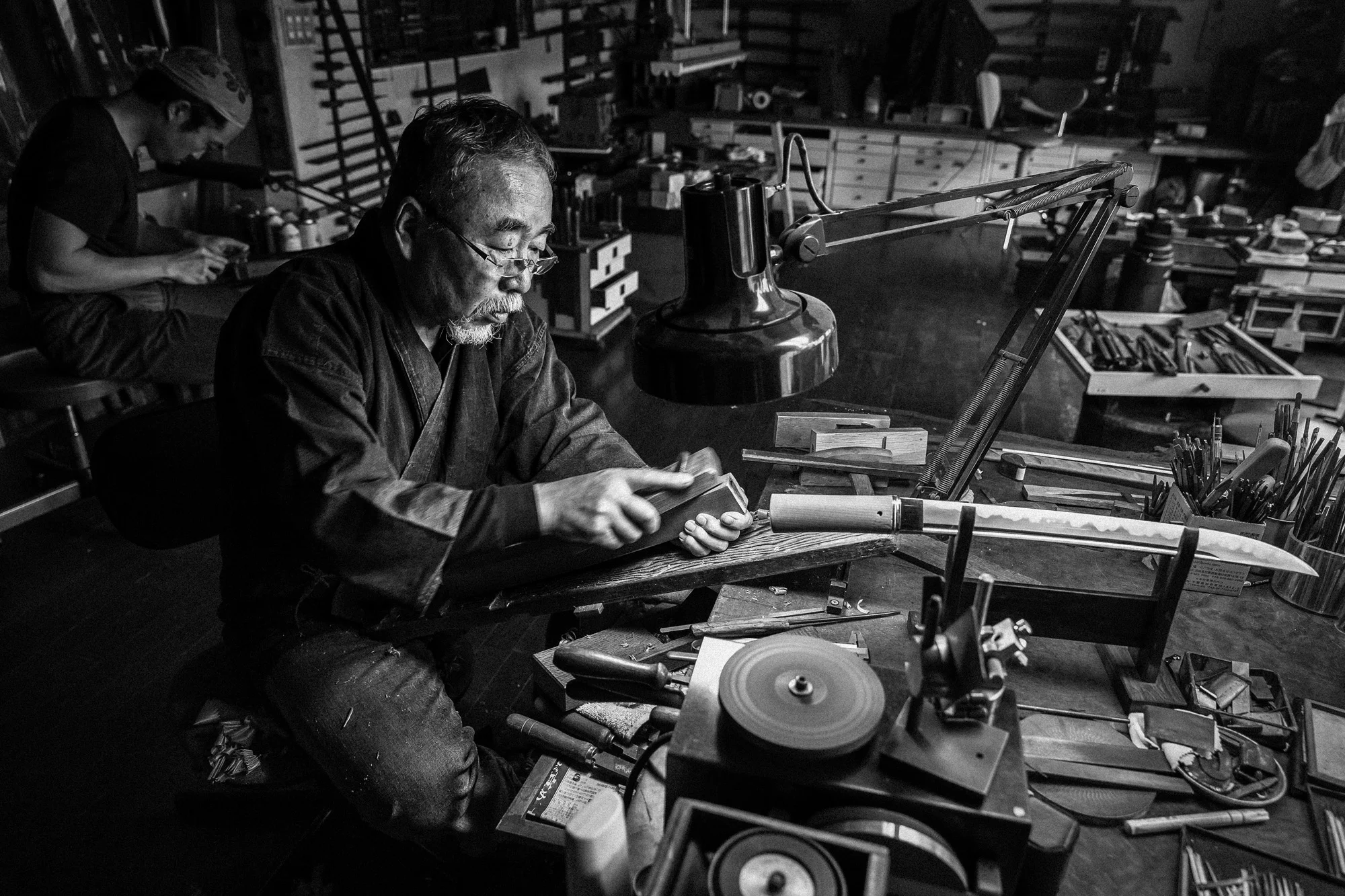
TOKYO, JAPAN, 22 OCTOBER 2014: Images inside the home and foundry of Master Japanese swordsmith Yoshindo Yoshihara, Tokyo, Japan. The Japanese sword is known globally for its quality and there is a centuries old tradition of swordmaking in Japan, stretching back over a 1000 years. These days it remains a profession of few craftsmen, with a even fewer master swordsmiths amongst them. The sword remains very popular in Japan and also globally. Prices can reach over 3 million Euros for an antique sword from a distinguished Samurai lineage. (Photo by Brent Stirton/Reportage by Getty Images
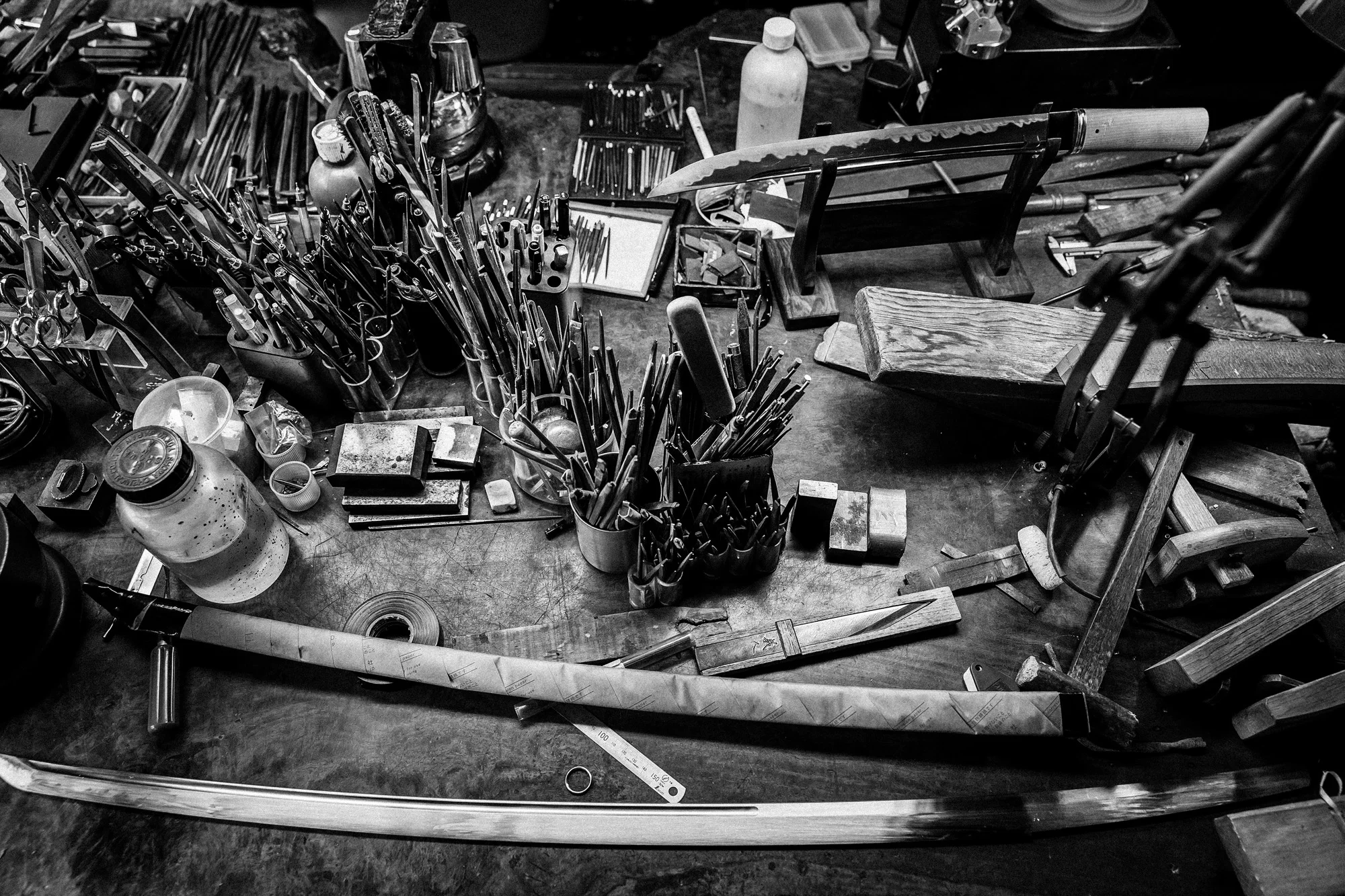
TOKYO, JAPAN, 22 OCTOBER 2014: Images inside the home and foundry of Master Japanese swordsmith Yoshindo Yoshihara, Tokyo, Japan. The Japanese sword is known globally for its quality and there is a centuries old tradition of swordmaking in Japan, stretching back over a 1000 years. These days it remains a profession of few craftsmen, with a even fewer master swordsmiths amongst them. The sword remains very popular in Japan and also globally. Prices can reach over 3 million Euros for an antique sword from a distinguished Samurai lineage. (Photo by Brent Stirton/Reportage by Getty Images

TOKYO, JAPAN, 22 OCTOBER 2014: Images inside the home and foundry of Master Japanese swordsmith Yoshindo Yoshihara, Tokyo, Japan. The Japanese sword is known globally for its quality and there is a centuries old tradition of swordmaking in Japan, stretching back over a 1000 years. These days it remains a profession of few craftsmen, with a even fewer master swordsmiths amongst them. The sword remains very popular in Japan and also globally. Prices can reach over 3 million Euros for an antique sword from a distinguished Samurai lineage. (Photo by Brent Stirton/Reportage by Getty Images
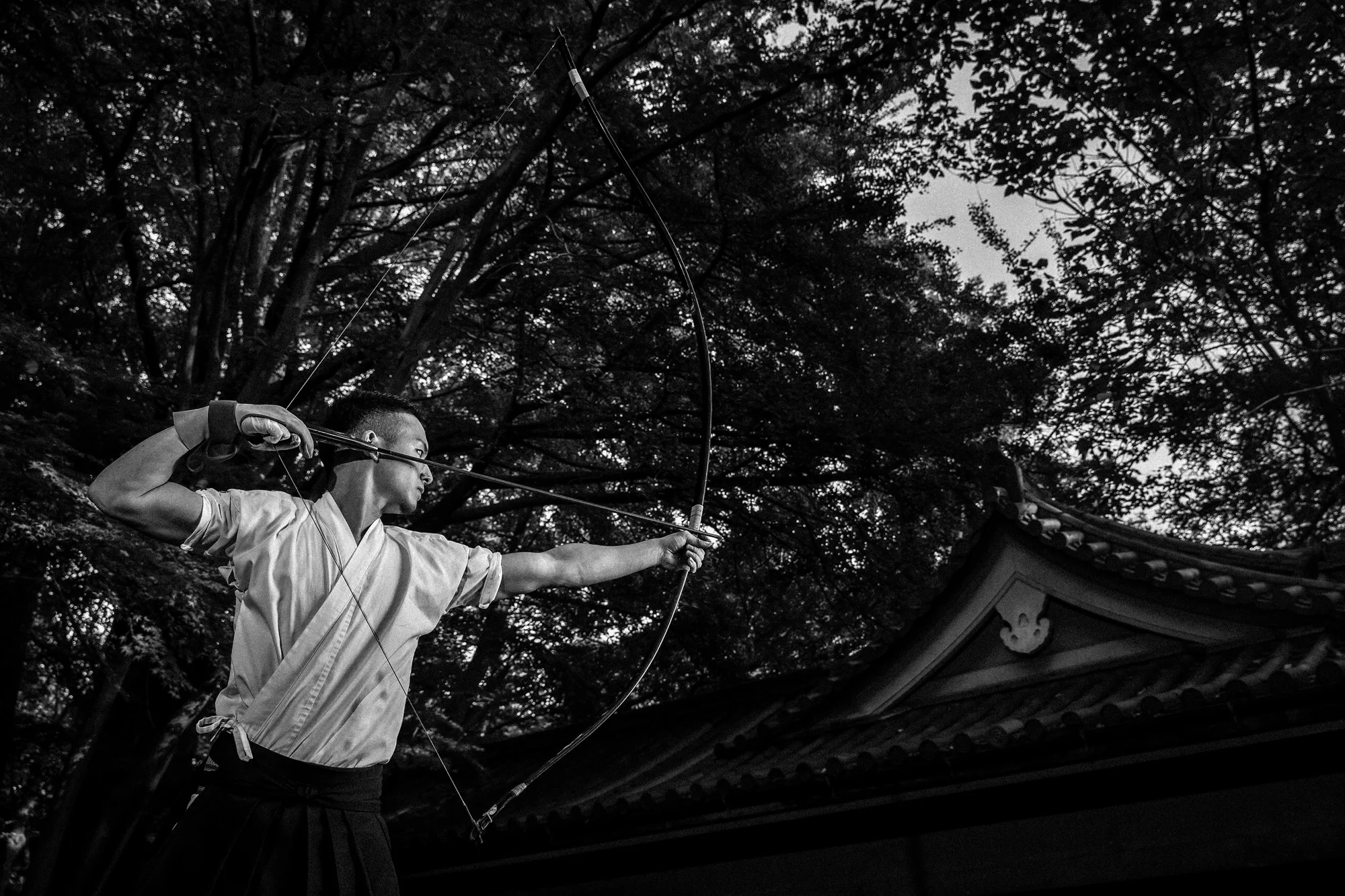
TOKYO UNIVERSITY, TOKYO, JAPAN, 25 OCTOBER 2014: Tokyo University Kyudo club in action at the University dojo, Tokyo, Japan. Kyudo is much more a moving meditation than a sport of archery, with an emphasis on breath, perfection of movement than an attempt to hit the target. It is seen as one of the most static of the Bushido Samurai arts. These young students all talk about the beauty and the meditative aspects of the sport and not the actual target shooting. All of the Samurai arts have aspects which stress these points of technique, artistry and flow. (Photo by Brent Stirton/Reportage by Getty Images for Le Figaro.)

TOKYO UNIVERSITY, TOKYO, JAPAN, 25 OCTOBER 2014: Tokyo University Kyudo club in action at the University dojo, Tokyo, Japan. Kyudo is much more a moving meditation than a sport of archery, with an emphasis on breath, perfection of movement than an attempt to hit the target. It is seen as one of the most static of the Bushido Samurai arts. These young students all talk about the beauty and the meditative aspects of the sport and not the actual target shooting. All of the Samurai arts have aspects which stress these points of technique, artistry and flow. (Photo by Brent Stirton/Reportage by Getty Images for Le Figaro.)

TOKYO UNIVERSITY, TOKYO, JAPAN, 25 OCTOBER 2014: Tokyo University Kyudo club in action at the University dojo, Tokyo, Japan. Kyudo is much more a moving meditation than a sport of archery, with an emphasis on breath, perfection of movement than an attempt to hit the target. It is seen as one of the most static of the Bushido Samurai arts. These young students all talk about the beauty and the meditative aspects of the sport and not the actual target shooting. All of the Samurai arts have aspects which stress these points of technique, artistry and flow. (Photo by Brent Stirton/Reportage by Getty Images for Le Figaro.)
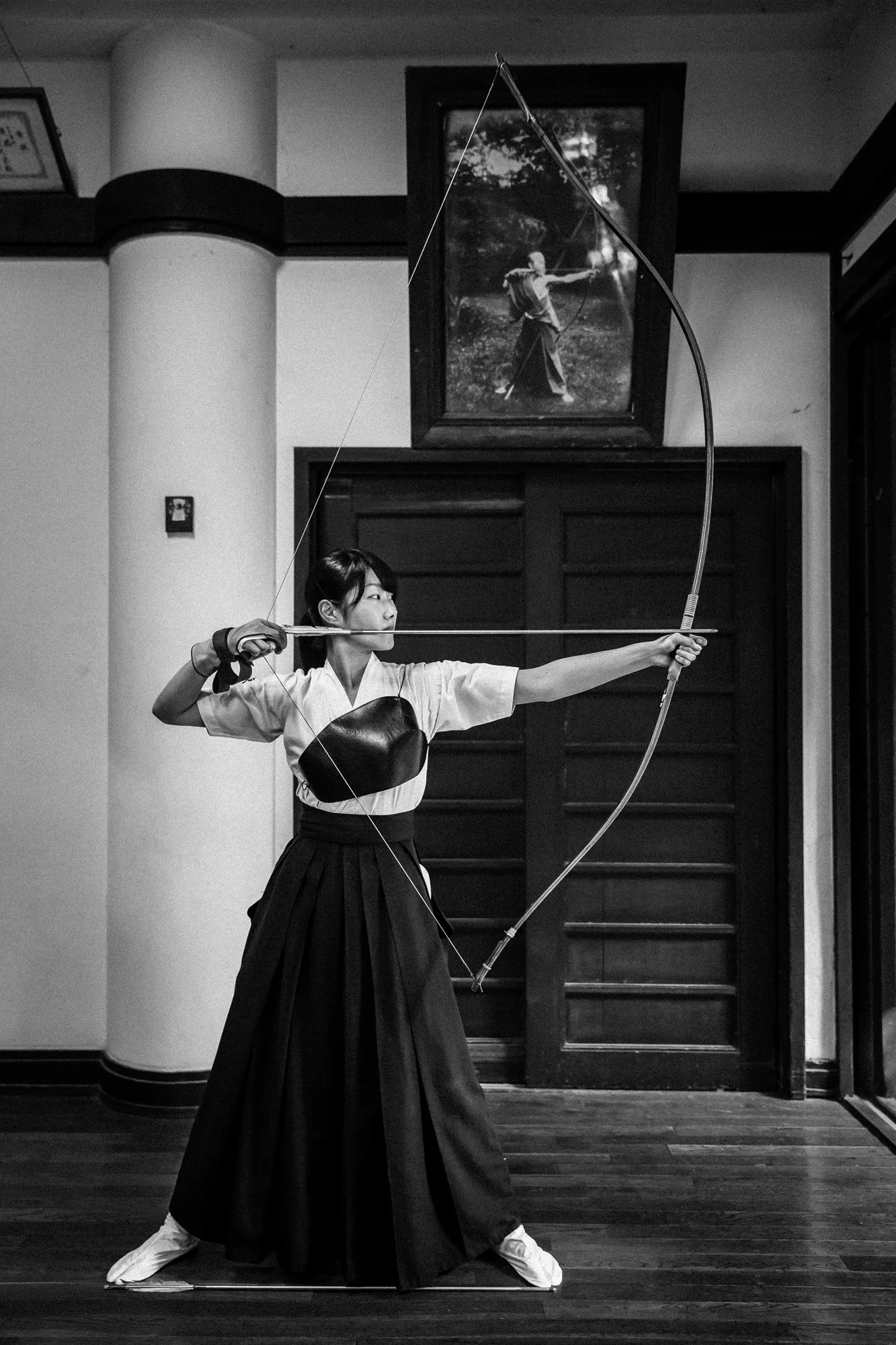
TOKYO UNIVERSITY, TOKYO, JAPAN, 25 OCTOBER 2014: Tokyo University Kyudo club in action at the University dojo, Tokyo, Japan. Kyudo is much more a moving meditation than a sport of archery, with an emphasis on breath, perfection of movement than an attempt to hit the target. It is seen as one of the most static of the Bushido Samurai arts. These young students all talk about the beauty and the meditative aspects of the sport and not the actual target shooting. All of the Samurai arts have aspects which stress these points of technique, artistry and flow. (Photo by Brent Stirton/Reportage by Getty Images for Le Figaro.)

TOKYO UNIVERSITY, TOKYO, JAPAN, 25 OCTOBER 2014: Tokyo University Kyudo club in action at the University dojo, Tokyo, Japan. Kyudo is much more a moving meditation than a sport of archery, with an emphasis on breath, perfection of movement than an attempt to hit the target. It is seen as one of the most static of the Bushido Samurai arts. These young students all talk about the beauty and the meditative aspects of the sport and not the actual target shooting. All of the Samurai arts have aspects which stress these points of technique, artistry and flow. (Photo by Brent Stirton/Reportage by Getty Images for Le Figaro.)

TOKYO UNIVERSITY, TOKYO, JAPAN, 25 OCTOBER 2014: Tokyo University Kyudo club in action at the University dojo, Tokyo, Japan. Kyudo is much more a moving meditation than a sport of archery, with an emphasis on breath, perfection of movement than an attempt to hit the target. It is seen as one of the most static of the Bushido Samurai arts. These young students all talk about the beauty and the meditative aspects of the sport and not the actual target shooting. All of the Samurai arts have aspects which stress these points of technique, artistry and flow. (Photo by Brent Stirton/Reportage by Getty Images for Le Figaro.)

TOKYO UNIVERSITY, TOKYO, JAPAN, 25 OCTOBER 2014: Tokyo University Kyudo club in action at the University dojo, Tokyo, Japan. Kyudo is much more a moving meditation than a sport of archery, with an emphasis on breath, perfection of movement than an attempt to hit the target. It is seen as one of the most static of the Bushido Samurai arts. These young students all talk about the beauty and the meditative aspects of the sport and not the actual target shooting. All of the Samurai arts have aspects which stress these points of technique, artistry and flow. (Photo by Brent Stirton/Reportage by Getty Images for Le Figaro.)

TOKYO UNIVERSITY, TOKYO, JAPAN, 25 OCTOBER 2014: Tokyo University Kyudo club in action at the University dojo, Tokyo, Japan. Kyudo is much more a moving meditation than a sport of archery, with an emphasis on breath, perfection of movement than an attempt to hit the target. It is seen as one of the most static of the Bushido Samurai arts. These young students all talk about the beauty and the meditative aspects of the sport and not the actual target shooting. All of the Samurai arts have aspects which stress these points of technique, artistry and flow. (Photo by Brent Stirton/Reportage by Getty Images for Le Figaro.)

TOKYO UNIVERSITY, TOKYO, JAPAN, 25 OCTOBER 2014: Tokyo University Kyudo club in action at the University dojo, Tokyo, Japan. Kyudo is much more a moving meditation than a sport of archery, with an emphasis on breath, perfection of movement than an attempt to hit the target. It is seen as one of the most static of the Bushido Samurai arts. These young students all talk about the beauty and the meditative aspects of the sport and not the actual target shooting. All of the Samurai arts have aspects which stress these points of technique, artistry and flow. (Photo by Brent Stirton/Reportage by Getty Images for Le Figaro.)

TOKYO UNIVERSITY, TOKYO, JAPAN, 25 OCTOBER 2014: Tokyo University Kyudo club in action at the University dojo, Tokyo, Japan. Kyudo is much more a moving meditation than a sport of archery, with an emphasis on breath, perfection of movement than an attempt to hit the target. It is seen as one of the most static of the Bushido Samurai arts. These young students all talk about the beauty and the meditative aspects of the sport and not the actual target shooting. All of the Samurai arts have aspects which stress these points of technique, artistry and flow. (Photo by Brent Stirton/Reportage by Getty Images for Le Figaro.)

TOKYO UNIVERSITY, TOKYO, JAPAN, 25 OCTOBER 2014: Tokyo University Kyudo club in action at the University dojo, Tokyo, Japan. Kyudo is much more a moving meditation than a sport of archery, with an emphasis on breath, perfection of movement than an attempt to hit the target. It is seen as one of the most static of the Bushido Samurai arts. These young students all talk about the beauty and the meditative aspects of the sport and not the actual target shooting. All of the Samurai arts have aspects which stress these points of technique, artistry and flow. (Photo by Brent Stirton/Reportage by Getty Images for Le Figaro.)

TOKYO UNIVERSITY, TOKYO, JAPAN, 25 OCTOBER 2014: Tokyo University Kyudo club in action at the University dojo, Tokyo, Japan. Kyudo is much more a moving meditation than a sport of archery, with an emphasis on breath, perfection of movement than an attempt to hit the target. It is seen as one of the most static of the Bushido Samurai arts. These young students all talk about the beauty and the meditative aspects of the sport and not the actual target shooting. All of the Samurai arts have aspects which stress these points of technique, artistry and flow. (Photo by Brent Stirton/Reportage by Getty Images for Le Figaro.)
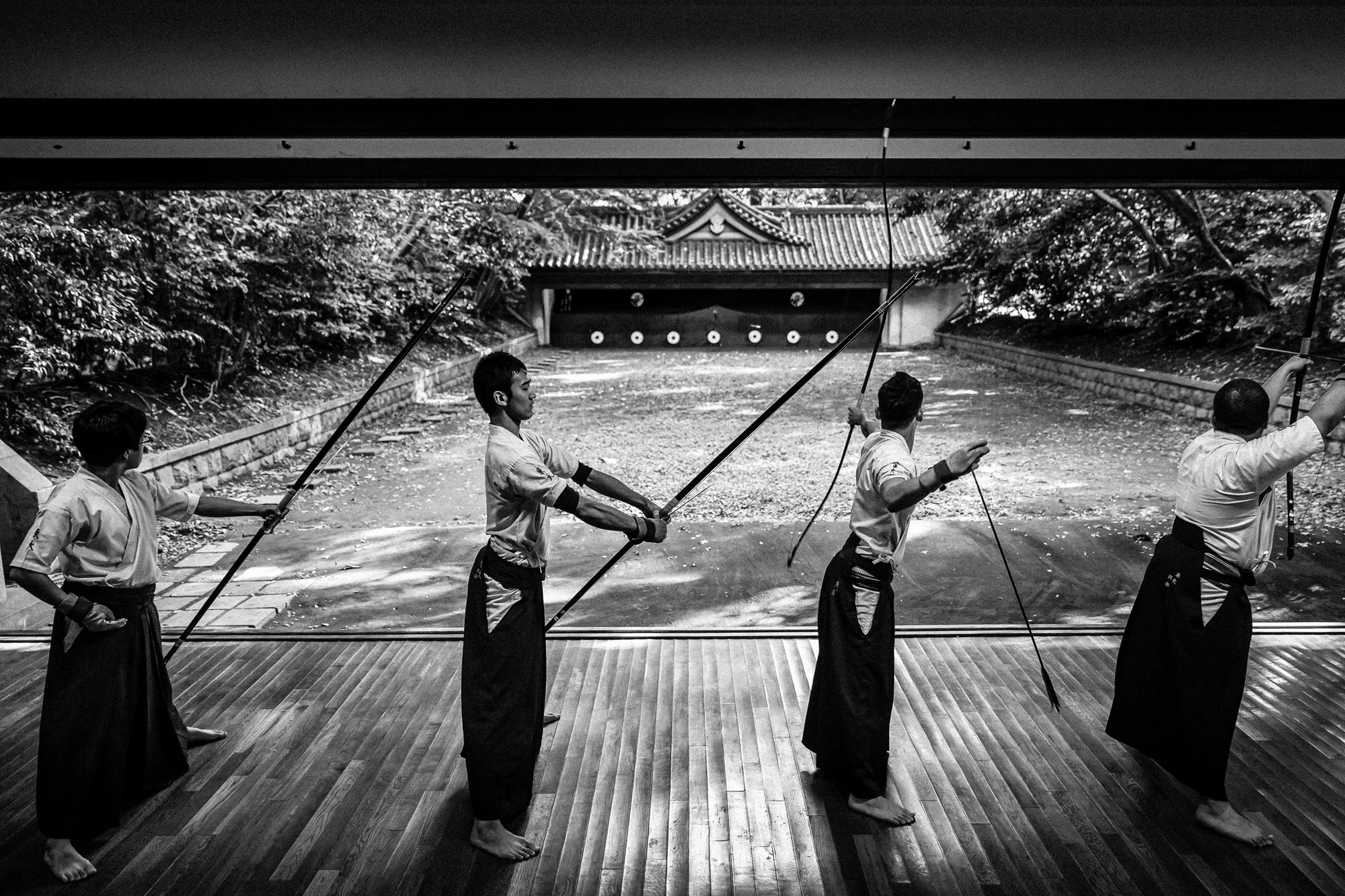
TOKYO UNIVERSITY, TOKYO, JAPAN, 25 OCTOBER 2014: Tokyo University Kyudo club in action at the University dojo, Tokyo, Japan. Kyudo is much more a moving meditation than a sport of archery, with an emphasis on breath, perfection of movement than an attempt to hit the target. It is seen as one of the most static of the Bushido Samurai arts. These young students all talk about the beauty and the meditative aspects of the sport and not the actual target shooting. All of the Samurai arts have aspects which stress these points of technique, artistry and flow. (Photo by Brent Stirton/Reportage by Getty Images for Le Figaro.)

TOKYO UNIVERSITY, TOKYO, JAPAN, 25 OCTOBER 2014: Tokyo University Kyudo club in action at the University dojo, Tokyo, Japan. Kyudo is much more a moving meditation than a sport of archery, with an emphasis on breath, perfection of movement than an attempt to hit the target. It is seen as one of the most static of the Bushido Samurai arts. These young students all talk about the beauty and the meditative aspects of the sport and not the actual target shooting. All of the Samurai arts have aspects which stress these points of technique, artistry and flow. (Photo by Brent Stirton/Reportage by Getty Images for Le Figaro.)

TOKYO UNIVERSITY, TOKYO, JAPAN, 25 OCTOBER 2014: Tokyo University Kyudo club in action at the University dojo, Tokyo, Japan. Kyudo is much more a moving meditation than a sport of archery, with an emphasis on breath, perfection of movement than an attempt to hit the target. It is seen as one of the most static of the Bushido Samurai arts. These young students all talk about the beauty and the meditative aspects of the sport and not the actual target shooting. All of the Samurai arts have aspects which stress these points of technique, artistry and flow. (Photo by Brent Stirton/Reportage by Getty Images for Le Figaro.)
